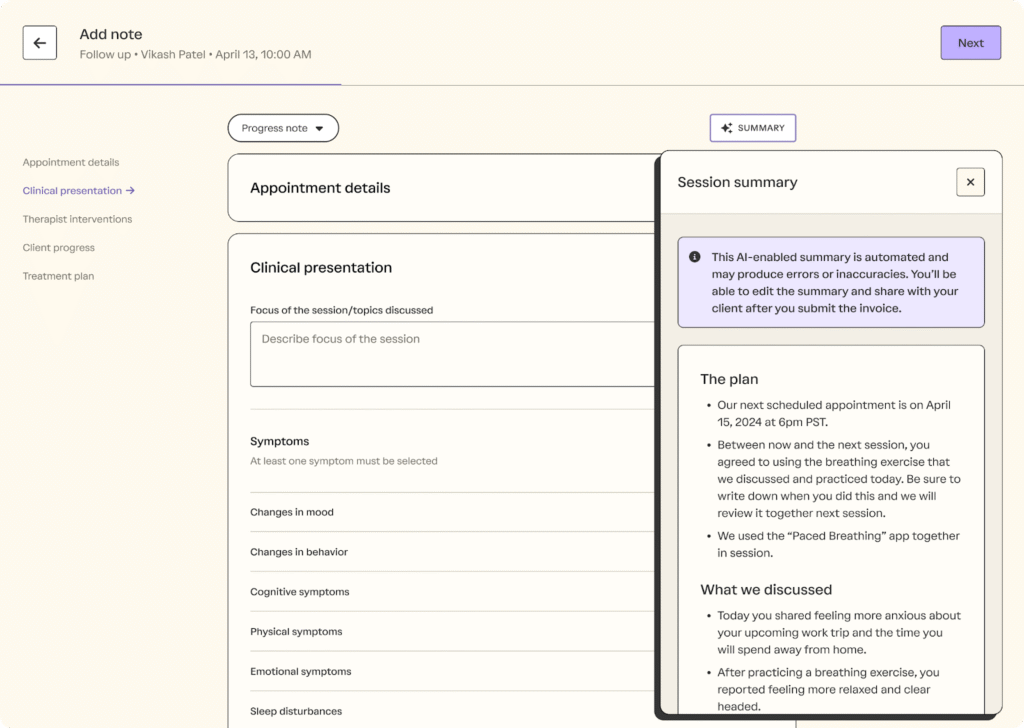My name is Tahara DeBarrows, and I’m a Licensed Marriage and Family Therapist (LMFT) specializing in attachment theory and assertiveness skills. I work primarily with individuals facing life transitions, relationship challenges, and workplace stressors. I’ve been a provider with Grow Therapy since 2021.
Grow Therapy recently rolled out a few telehealth tools meant to help streamline administrative tasks, enhance client engagement, and support clinicians in delivering high-quality care. These enhancements have optimized my workflow and helped me with more thorough record-keeping, which ultimately benefits my clients and how I care for them.
Transforming administrative tasks
One of the most impactful new tools is the AI summarization. This new feature has significantly improved the efficiency and accuracy of my note-taking. By automatically generating after-visit summaries (AVS) and note drafts, the tool allows me to review and refine documentation quickly.
During the session, the tool automates transcription, then after each session ends it generates a summary. This allows me to focus more on client engagement than administrative tasks. The AI-generated session summaries are stored securely, and I can access them for review and approval within a 30-day window, ensuring accuracy and compliance with regulations.
The new AI tools have allowed me to deepen my focus during sessions, as I no longer have to divide my attention between the conversation with my client and note-taking.
When I first started using the tools, I noticed how easy they were to engage with. To activate session summaries, I could just select the transcription icon when meeting virtually with a client. This intuitive feature reduces disruptions and enables me to concentrate fully on providing high-quality care.
Another new tool, in-session whiteboarding, makes it easy to enhance therapeutic discussions, incorporate interactive elements, and foster collaboration in a user-friendly experience.
Improving the client experience
The new tools have allowed me to deepen my focus during sessions. For example, the AI-enabled summarization tool means I no longer have to divide my attention between the conversation with my client and note-taking. This has resulted in more meaningful client interactions and improved therapeutic rapport.
My clients appreciate the transparency and control provided by Grow’s new AI summarization process.
The new whiteboarding tool has also added a lot to the client experience due to its ability to help me generate and customize visuals for clients. This creates a more inclusive and collaborative experience for clients who benefit from visual aids. I can use it to map thoughts, emotions, and coping strategies, which can also increase client engagement.
My clients appreciate the transparency and control provided by Grow’s new AI summarization process. Before transcription begins, client consent is explicitly obtained, and they have the option to pause the process at any time. This level of autonomy fosters trust and enhances client comfort throughout their sessions.
Clinicians may have questions about how to engage their clients with Grow’s new AI tools. I’ve found obtaining client consent to be straightforward, as I emphasize the benefits of AI-assisted documentation, including improved accuracy and reduced administrative delays. When using Grow’s AI tools for the first time with a client, I emphasize that their information remains private and is never shared inappropriately. I also explain how these tools help structure our sessions and provide an organized summary, streamlining the note-taking process. By explaining how the tool enhances their care experience, I have found most clients willing to participate.
Supporting self-care for therapists
Reducing my administrative workload has enabled me to dedicate more time to self-care, a crucial factor in preventing burnout. With less time spent on documentation, I can balance my professional responsibilities more effectively, leading to greater job satisfaction and sustained well-being.
Overall, these tools help me free up time so that I can engage in restorative activities such as mindfulness or one of my hobbies.
For example, I like to finish my notes on time, but by the end of the day, it feels like they’ve accumulated into a big task. The AI summarization tool helps me stay on top of my notes because they are automatically generated.
Using the whiteboard during sessions has reduced the cognitive overload that I would sometimes experience. During complex discussions, writing or drawing on the whiteboard reinforces what I’m communicating to the client, allowing me to focus on the conversation without feeling overwhelmed. This helps me feel more effective during sessions, leading to more fulfillment overall and a reduction in the amount of time I spend thinking about sessions once they’re complete.
Overall, these tools help me free up time so that I can engage in restorative activities such as mindfulness or one of my hobbies. The extra time it gives allows me to take longer breaks from the screen to engage in a quick reset activity when needed. By streamlining my workflow, I’m able to keep work at work and reclaim more time for myself.
New technology that benefits both clients and clinicians
The integration of Grow AI into my clinical practice has significantly decreased administrative burdens, enhanced documentation accuracy, and strengthened data security. By minimizing the time spent on session notes, I can dedicate more attention to direct client care, creating a more efficient and client-centered practice.
The after-visit summary feature has been particularly beneficial in maintaining accurate records with minimal effort. Furthermore, visually documenting interventions with the whiteboard tools has helped me to be more intentional during my sessions, which has helped me maintain a high level of care. As AI technology continues to evolve, I look forward to further innovations that will refine and enhance the delivery of mental health care services.

